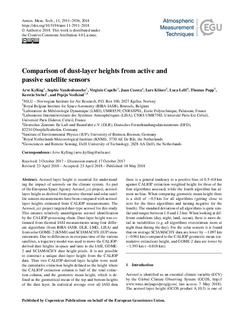| dc.contributor.author | Kylling, Arve | |
| dc.contributor.author | Vandenbussche, Sophie | |
| dc.contributor.author | Capelle, Virginie | |
| dc.contributor.author | Cuesta, Juan | |
| dc.contributor.author | Klüser, Lars | |
| dc.contributor.author | Lelli, Luca | |
| dc.contributor.author | Popp, Thomas | |
| dc.contributor.author | Stebel, Kerstin | |
| dc.contributor.author | Veefkind, Pepijn | |
| dc.date.accessioned | 2018-06-05T12:16:16Z | |
| dc.date.available | 2018-06-05T12:16:16Z | |
| dc.date.created | 2018-05-25T09:44:51Z | |
| dc.date.issued | 2018 | |
| dc.identifier.citation | Atmospheric Measurement Techniques. 2018, 11 2911-2936. | nb_NO |
| dc.identifier.issn | 1867-8548 | |
| dc.identifier.uri | http://hdl.handle.net/11250/2500388 | |
| dc.description.abstract | Aerosol-layer height is essential for understanding the impact of aerosols on the climate system. As part of the European Space Agency Aerosol_cci project, aerosol-layer height as derived from passive thermal and solar satellite sensors measurements have been compared with aerosol-layer heights estimated from CALIOP measurements. The Aerosol_cci project targeted dust-type aerosol for this study. This ensures relatively unambiguous aerosol identification by the CALIOP processing chain. Dust-layer height was estimated from thermal IASI measurements using four different algorithms (from BIRA-IASB, DLR, LMD, LISA) and from solar GOME-2 (KNMI) and SCIAMACHY (IUP) measurements. Due to differences in overpass time of the various satellites, a trajectory model was used to move the CALIOP-derived dust heights in space and time to the IASI, GOME-2 and SCIAMACHY dust height pixels. It is not possible to construct a unique dust-layer height from the CALIOP data. Thus two CALIOP-derived layer heights were used: the cumulative extinction height defined as the height where the CALIOP extinction column is half of the total extinction column, and the geometric mean height, which is defined as the geometrical mean of the top and bottom heights of the dust layer. In statistical average over all IASI data there is a general tendency to a positive bias of 0.5–0.8 km against CALIOP extinction-weighted height for three of the four algorithms assessed, while the fourth algorithm has almost no bias. When comparing geometric mean height there is a shift of −0.5 km for all algorithms (getting close to zero for the three algorithms and turning negative for the fourth). The standard deviation of all algorithms is quite similar and ranges between 1.0 and 1.3 km. When looking at different conditions (day, night, land, ocean), there is more detail in variabilities (e.g. all algorithms overestimate more at night than during the day). For the solar sensors it is found that on average SCIAMACHY data are lower by −1.097 km (−0.961 km) compared to the CALIOP geometric mean (cumulative extinction) height, and GOME-2 data are lower by −1.393 km (−0.818 km). | nb_NO |
| dc.language.iso | eng | nb_NO |
| dc.rights | Navngivelse 4.0 Internasjonal | * |
| dc.rights.uri | http://creativecommons.org/licenses/by/4.0/deed.no | * |
| dc.subject | Fjernmåling | nb_NO |
| dc.subject | Remote sensing | nb_NO |
| dc.subject | Atmosfære og klima | nb_NO |
| dc.subject | Atmosphere and climate | nb_NO |
| dc.subject | Aerosoler og partikler | nb_NO |
| dc.subject | Aerosols and particles | nb_NO |
| dc.title | Comparison of dust-layer heights from active and passive satellite sensors | nb_NO |
| dc.title.alternative | Comparison of dust-layer heights from active and passive satellite sensors | nb_NO |
| dc.type | Journal article | nb_NO |
| dc.type | Peer reviewed | nb_NO |
| dc.description.version | publishedVersion | nb_NO |
| dc.rights.holder | © Author(s) 2018 | nb_NO |
| dc.source.pagenumber | 2911-2936 | nb_NO |
| dc.source.volume | 11 | nb_NO |
| dc.source.journal | Atmospheric Measurement Techniques | nb_NO |
| dc.identifier.doi | 10.5194/amt-11-2911-2018 | |
| dc.identifier.cristin | 1586655 | |
| dc.relation.project | NILU - Norsk institutt for luftforskning: 110134 | nb_NO |
| dc.relation.project | ESA - den europeiske romfartsorganisasjonen: 4000109874/14/I-NB | nb_NO |
| cristin.unitcode | 7460,57,0,0 | |
| cristin.unitname | Atmosfære og klima | |
| cristin.ispublished | true | |
| cristin.fulltext | original | |
| cristin.qualitycode | 1 | |

